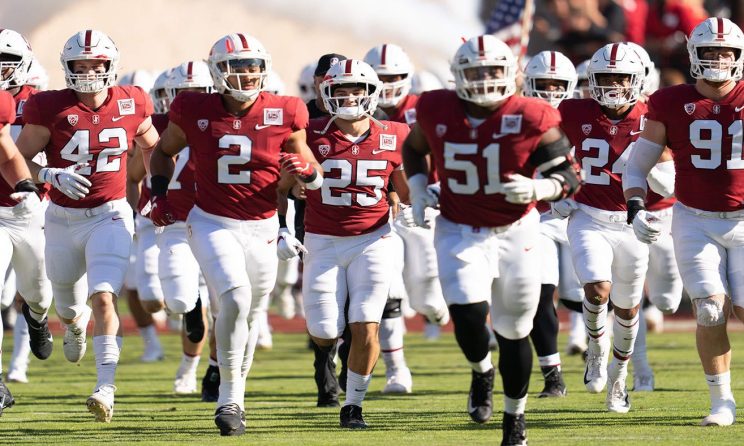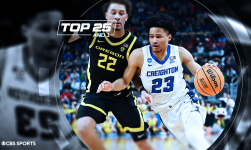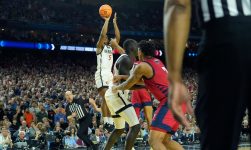
The 2023 version of conference realignment will go down as one of the most chaotic in college athletics history. The Pac-12 as we know it is all but gone after more than 100 years of existence, with 10 of its 12 members defecting to the other power conferences.
Stanford and California became the latest schools to leave as they join the ACC in 2024, but they will reportedly do so at a reduced media rights revenue share of around 30% for the next seven years. SMU will also join the ACC from the American, though the Mustangs will not receive any base share for nine years.
Previously, USC, UCLA, Oregon and Washington opted to join the Big Ten; Arizona, Arizona State, Colorado and Utah are heading to the Big 12.
Now, only two Pac-12 schools remain without a home. Oregon State and Washington State have expressed interest in rebuilding the Pac-12, but that possibility could be off the table in light of the most recent departures. The AAC also dismissed interest in adding the schools, leaving the Mountain West as a likely last resort.
Eight of the Pac-12’s departing members will make more money in their new homes. Stanford and Cal will make less, while Oregon State and Washington State could make substantially less.
Here are the winners and losers of perhaps the most destructive round of realignment in history:
Losers: Oregon State and Washington State
At the (apparent) end of this realignment saga, 63 of the 65 legacy Power Five members found power conference homes. Five other schools — BYU, Cincinnati, Houston, SMU and UCF– received promotions to power conferences. Somehow, at the end of it all, only Oregon State and Washington State got screwed.
There are financial reasons why the Pacific Northwest pair wasn’t quite as attractive to major college conferences, but none offer much relief. Despite their relatively small size, both schools have passionate fanbases. A Washington State flag has flown in the background of ESPN’s “College GameDay” set for the past 20 years. Perhaps most unfortunate, the pair is likely to move out of the spotlight of a power conference right as Oregon State appears poised to reach national competitiveness under coach Jonathan Smith.
Winner: SMU
The Mustangs fell into one of the biggest holes in college football history after receiving the NCAA’s death penalty in 1987. Left out of Big 12 expansion in 1996, the program traversed the WAC, Conference USA and most recently the American for decades. When the Big 12 added four new members over the summer, SMU was once again overlooked.
Now, the Mustangs are finally moving to a power conference for the first time in nearly 30 years. SMU’s move is unprecedented in its hubris: The Mustangs agreed to move to the ACC in exchange for zero conference distribution for most of the next decade. But for a wealthy private school in one of America’s richest locales, the branding and exposure might still be worth it.
SMU reeled in the best recruiting class among Group of Five schools by more than 25 spots in 2023. Joining a power league should only supercharge recruiting.
Losers: Stanford and Cal
The Bay Area pairing received a life raft, but at what cost? The duo will now play a travel schedule — across numerous sports — that makes the Big Ten look downright logical. The closest existing ACC school is Louisville, which sits just under 2,000 miles away. SMU provides some relief at only 1,500 miles.
To make matters worse, Stanford and Cal were members of the Pac-12 when the league failed to negotiate a new media rights deal. With ESPN reportedly offering in the neighborhood of $30 million per school in annual payout, the Pac-12 supposedly countered with a $50 million-per-member price tag. Now, Stanford and Cal will likely make closer to $20 million through the first seven years of their agreement with the ACC, much closer to the AAC than any other power program.
Mix massive distances and travel budgets with athletic departments that will suddenly be making significantly less money, and you’ve got a recipe for quite the headache.
Winner: Colorado
The Buffaloes have quietly been one of the headiest programs in realignment over the last 15 years. When it looked like the Big 12 could go under in 2010, Colorado allied itself with the then-safe ground of the Pac-12. Now, Colorado ran back to its old friends in the Big 12 right before the foundation started crumbling in the Pac-12.
Unlike every other team on this list, Colorado’s move actually reunites it with a handful of historic rivals from the old Big Eight. The Buffaloes have played Kansas 70 times and Iowa State 65 times and built rivalries with schools in Texas and Oklahoma during a stint in the Big 12.
Perhaps most importantly, rejoining the Big 12 also allows coach Deion Sanders to go down into Texas and recruit. Sanders spent nearly a decade coaching high school players in Texas after playing for the Dallas Cowboys. Creating a recruiting pipeline out of the Lone Star State appears be a priority and could pay off for Coach Prime.
Losers: Oregon and Washington
The Ducks and Huskies have been among the most watched and successful athletic departments in the country over the past 30 years. Both programs earned a rightful place in one of the top conferences in college football. However, their arrival comes through the back door with a diminished share.
Oregon has won a College Football Playoff game and played for national championships in 2010 and 2014. Washington has four top-15 finishes in the past seven years, including an 11-2 season with an Alamo Bowl victory in 2022. Now, both programs will make substantially less money than Maryland and Northwestern to play in the same conference.
To make matters worse, the Big Ten is a logistical nightmare for the newest West Coast additions. The nearest current Big Ten member is Nebraska, more than 1,600 miles away from both schools. While USC and UCLA provide a Western wing of the conference, even those schools are more than 800 miles away. At least USC and UCLA earn $75 million per year to make the nightmare trips; Oregon and Washington will be struggling on a budget.
Winner: Arizona
Football moves the levers of power in college athletics, but few schools can be happier about the boon to their basketball programs than Arizona. The Wildcats rank among the greatest college hoops programs of all time, and they are now set to join the unquestioned top basketball league in college athletics.
Kansas and Baylor are responsible for two of the last three national championships in college basketball. Houston and Texas Tech have also each posted trips to the Final Four since 2019. Eight Big 12 schools finished top 30 in KenPom in 2023, not even counting Arizona’s addition.
There’s plenty to like on the football side, especially the ability to recruit Texas. However, Arizona is one of the true game-changing basketball programs in the nation, and it will be a fantastic fit in the Big 12.
Loser: Utah
Life has been good for Utah over the past decade. Kyle Whittingham has built up one of the top programs in college football and comes off of back-to-back Pac-12 championships. Perhaps equally as important, Utah has left rival BYU in the dust since moving up and playing the best and brightest of West Coast college football programs.
When Utah joined the Pac-12 in 2011, it represented a turning point against its rivals at BYU. The Cougars held a 29-20 advantage against the Utes when each were members of the WAC and Mountain West, but that flipped when Utah got a Pac-12 invitation. The Utes have won eight of nine against the Cougars since joining the Power Five with seven AP Top 25 finishes in the past nine years.
Now, the two biggest Utah schools are set to become conference-mates once again, and the balance of power in the state is up in the air. Granted, the Utes are still in great shape under Whittingham, one of the top coaches in the sport. However, BYU’s elevation to the same conference as Utah has massive long-term implications for both programs as they attempt to claw their way onto the national stage.
Winner: The Big 12
One year ago, Pac-12 commissioner George Kliavkoff took a jab at new Big 12 commissioner Brett Yormark during his remarks at Pac-12 Media Day about the positioning of their two leagues.
“You look at the metrics, you look at the numbers, and any way you cut and slice and dice the numbers, you come to the conclusion that no Pac-12 school is going to the Big 12,” Kliavkoff told The Athletic.
One year later, Yormark has completely outmaneuvered Kliavkoff and given his conference the future that the Pac-12 once thought a birthright. Four Pac-12 programs ultimately decided to join the Big 12, giving the league a second life that few expected after Texas and Oklahoma opted to join the SEC.
Now, the Big 12 has emerged as easily the best basketball league in college athletics and a highly competitive football group. With16 teams, the league is highly stable heading into the future. For the eight legacy schools left behind after Texas and OU’s decision, the situation is better than they ever could have imagined.
Loser: West Coast athletics
It’s no secret that interest and participation in sports has been waning on the West Coast, especially in football. The last football team from the region to win a national championship was USC in 2004. The West Coast’s last basketball title was Lute Olson’s Arizona team in 1997.
However, the collapse of the Pac-12 has far worse implications for West Coast athletics than just the revenue sports. Stanford has won the NCAA Directors Cup 26 times since it was created in 1994. California has eight top-10 finishes, tied with Arizona for 12th all time. A number of non-revenue sport opportunities have been created because of the money paid out by being part of a major football league.
Joining the ACC will be at least some buffer financially, but sitting at only 30% share makes things difficult. On top of that, even at the well-funded schools like Oregon, UCLA and USC, will the insane costs of flying cross-country for routine conference games be a major deterrent to fielding robust athletic departments?
The collapse of the Pac-12 feels like a canary in the coal mine for the total destruction of major investment in non-revenue sports on the West Coast. If that happens, the consequences will go infinitely further than simply football.
TBD: Arizona State
The good? Arizona State found a safe haven and will have the opportunity to play power conference sports heading forward. The Territorial Cup will live on. Getting to play a national college football schedule could be a massive benefit for ASU’s student acquisition; the university already boasts a massive student body and robust online education program.
The bad? Leadership was upfront that they did not want the Pac-12 to fold or to join the Big 12. The Sun Devils were essentially forced into this role by circumstance. Arizona State does not have an obvious identity as an athletic department within the Big 12 Conference, especially as the Sun Devils search for their first AP Top 25 finish in either football or basketball since 2014.
The money and opportunity to play in the Big 12 is enough to make the move, and Kenny Dillingham could be the perfect football coach to oversee it. Still, Arizona State athletics will have to do some soul searching as it leaves the West Coast for Flyover Country.
Loser: George Kliavkoff
When Pac-12 commissioner George Kliavkoff was hired, many hoped that his experience as president of entertainment and sports at MGM Resorts International would give him a unique ability to prepare for college athletics’ modern age. Instead, it only set the stage for another entertainment executive — the Big 12’s Brett Yormark — to run circles around the Pac-12.
While almost every factor that led to the death of the Pac-12 dates back to Kliavkoff’s predecessor, Larry Scott, Kliavkoff failed to remedy any of the league’s ills. He let the Big 12 jump the Pac-12 in line with ESPN and Fox, leading to limited windows available for the league to fill. Kliavkoff looked to streaming for a safety net, but failed to deliver competitive numbers. On judgement day, Kliavkoff was unaware of Oregon and Washington’s maneuvering behind the scenes, leaving him with empty hands as the pair ran off to the Big Ten on Friday.
Now, a 108-year-old athletic association is essentially gone. Only two out of 12 members remain, meaning that any future league would hold almost zero DNA with the historic conference. Scott deserves the lion’s share of the blame, but Kliavkoff failed to remotely stop the bleeding when it became time to save the league. His tenure as a college sports administrator will be defined by overseeing the collapse of the Pac-12.





